Abstract
Cell killing and mutation induction by cis- and trans-Pt(NH3)2Cl2 in Escherichia coli were examined by studying forward mutagenesis in the lacI gene in cells with different repair capacities. Survival experiments showed that repair-proficient cells were slightly more sensitive for the cis isomer than for the trans isomer, whereas repair-deficient RecA and UvrB cells were extremely sensitive only for the cis compound. cis-Pt(NH3)2Cl2 induced mutagenesis in both wild-type cells and RecA cells but not in UvrB cells; whereas no detectable mutagenesis was induced by treatment with the trans compound. Examination of the nature of the mutations induced by cis-Pt(NH3)2Cl2, by using the LacI system, revealed that base-pair substitutions leading to nonsense mutants are only induced in wild-type cells, suggesting that the intact products of both the uvrB and the recA gene are necessary for the repair responsible for this type of mutagenesis. Investigation of the nonsense mutants reveals that 70% of these mutations result from GC leads to TA or GC leads to AT substitutions at sites where the guanine is part of a GAG or GCG sequence. These results are discussed in relation to existing theories on the interaction between Pt compounds and DNA. A model for Pt--DNA adducts, leading to base-pair substitutions, is proposed.
Full text
PDF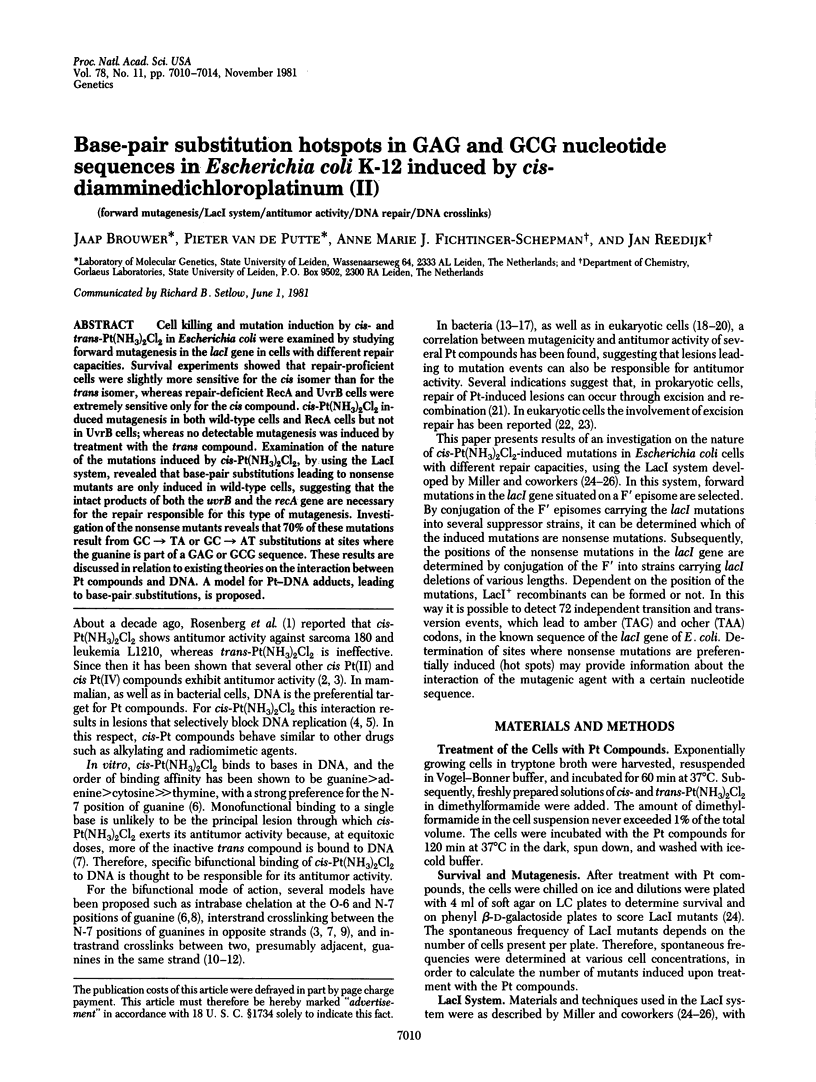
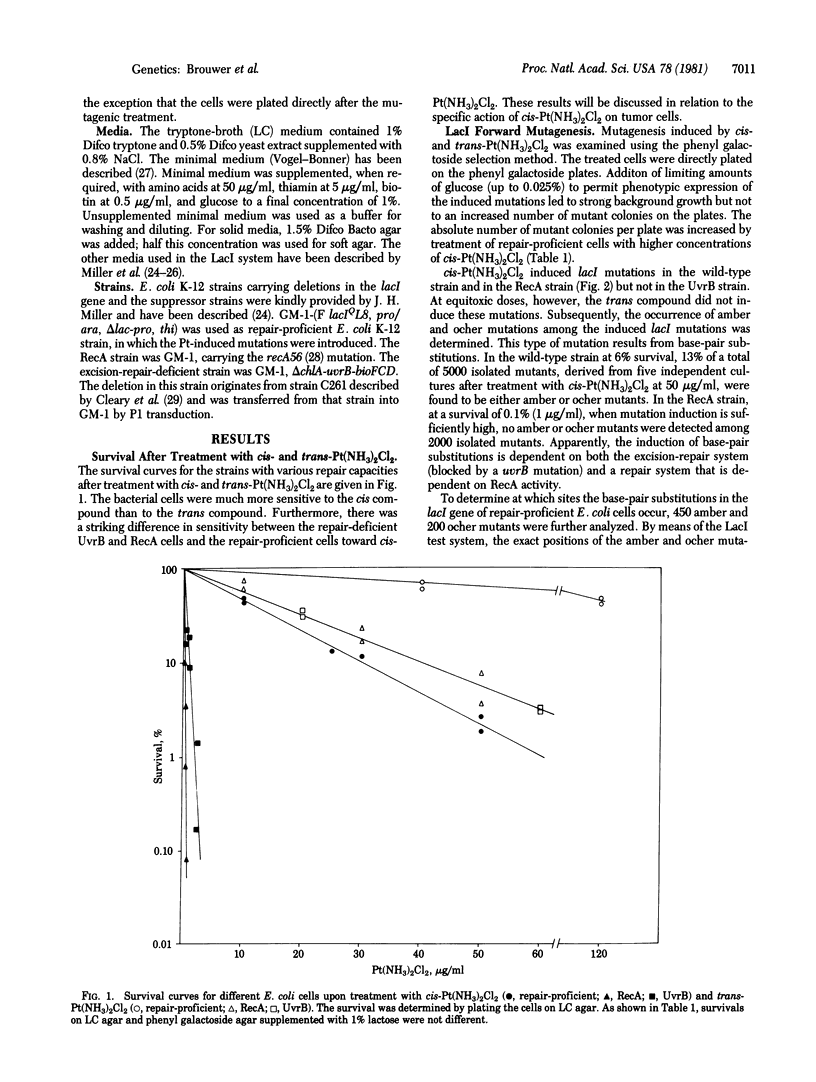
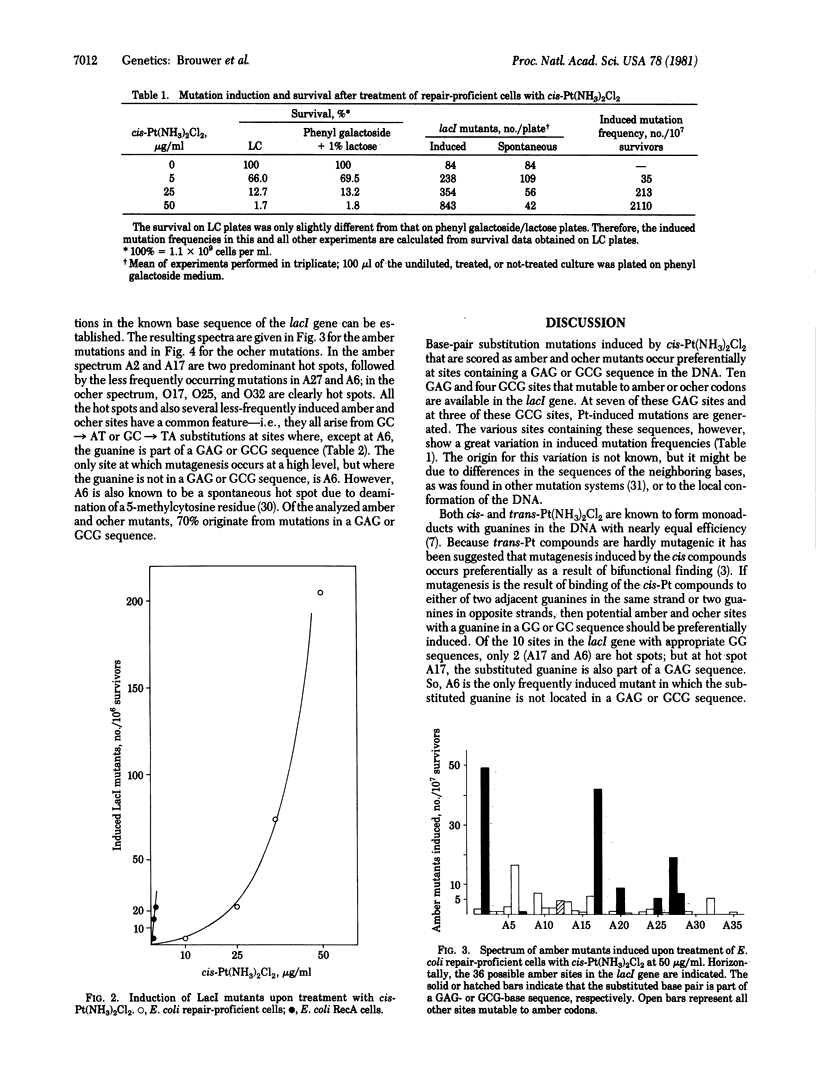
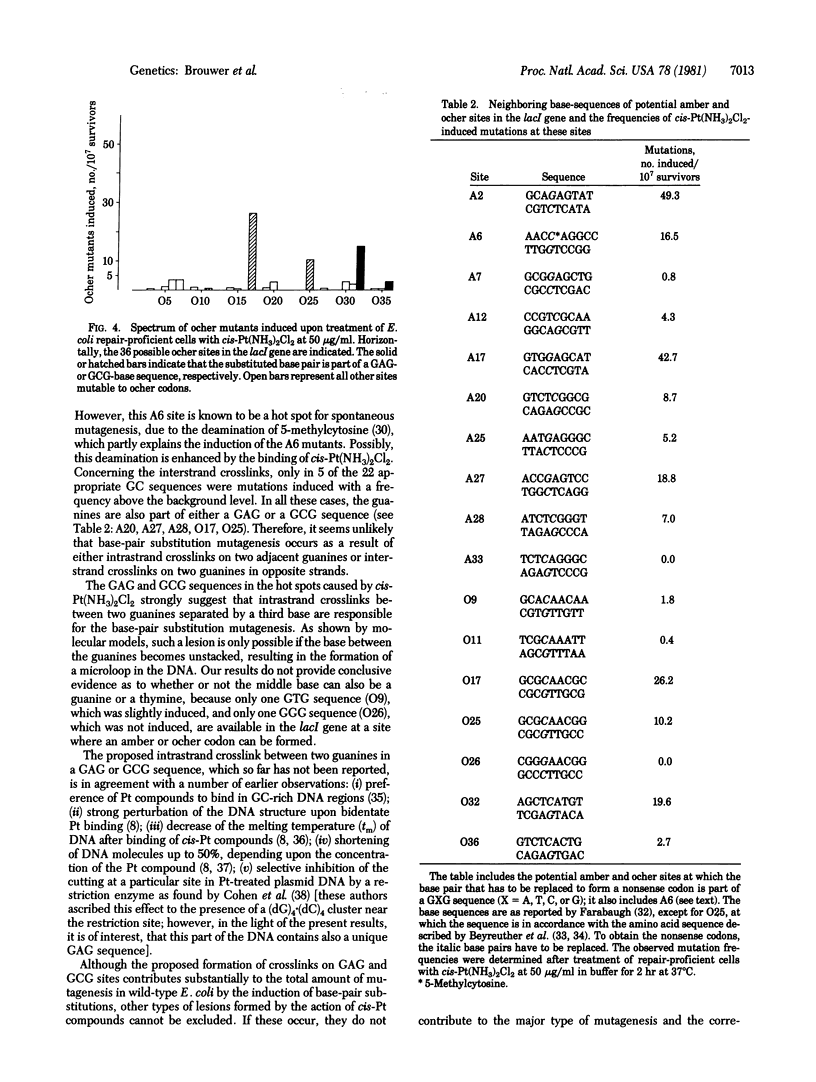
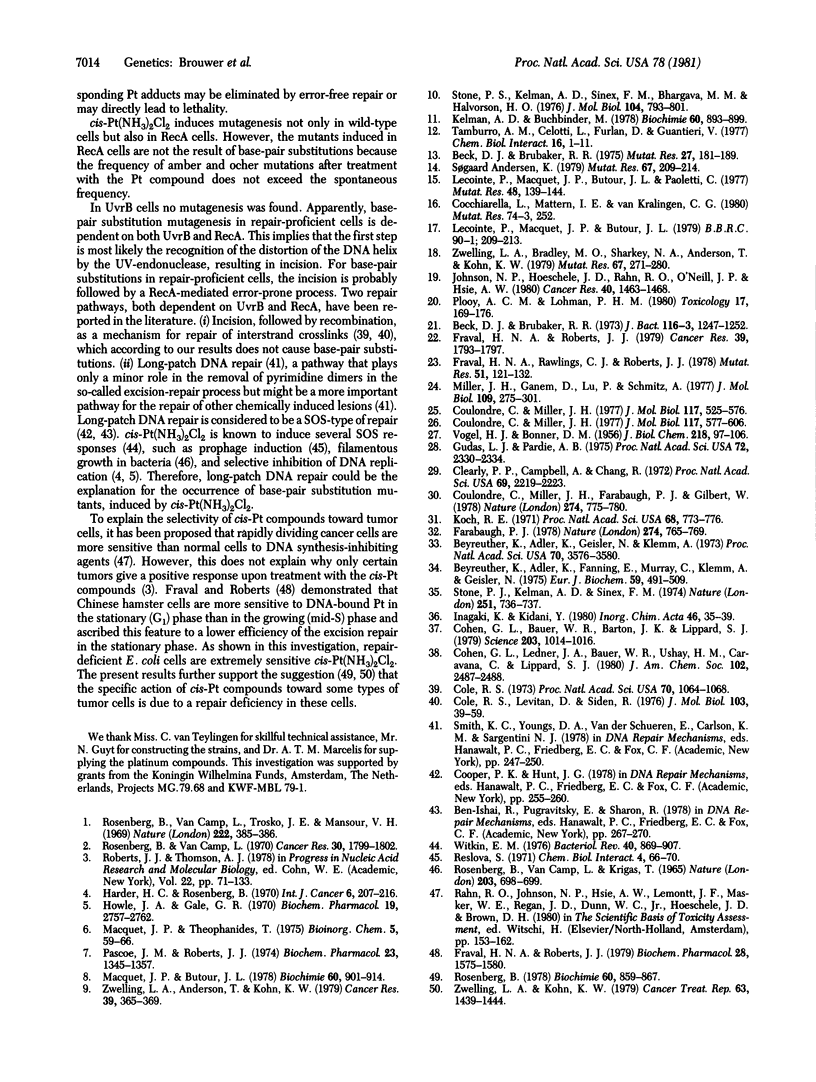
Selected References
These references are in PubMed. This may not be the complete list of references from this article.
- Andersen K. S. Platinum(II) complexes generate frame-shift mutations in test strains of Salmonella typhimurium. Mutat Res. 1979 Jul;67(3):209–214. doi: 10.1016/0165-1218(79)90014-4. [DOI] [PubMed] [Google Scholar]
- Beck D. J., Brubaker R. R. Effect of cis-platinum(II)diamminodichloride on wild type and deoxyribonucleic acid repair deficient mutants of Escherichia coli. J Bacteriol. 1973 Dec;116(3):1247–1252. doi: 10.1128/jb.116.3.1247-1252.1973. [DOI] [PMC free article] [PubMed] [Google Scholar]
- Beck D. J., Brubaker R. R. Mutagenic properties of cis-plantinum(II)diammino-dichloride in Escherichia coli. Mutat Res. 1975 Feb;27(2):181–189. doi: 10.1016/0027-5107(75)90077-9. [DOI] [PubMed] [Google Scholar]
- Beyreuther K., Adler K., Fanning E., Murray C., Klemm A., Geisler N. Amino-acid sequence of lac repressor from Escherichia coli. Isolation, sequence analysis and sequence assembly of tryptic peptides and cyanogen-bromide fragments. Eur J Biochem. 1975 Nov 15;59(2):491–509. doi: 10.1111/j.1432-1033.1975.tb02477.x. [DOI] [PubMed] [Google Scholar]
- Beyreuther K., Adler K., Geisler N., Klemm A. The amino-acid sequence of lac repressor. Proc Natl Acad Sci U S A. 1973 Dec;70(12):3576–3580. doi: 10.1073/pnas.70.12.3576. [DOI] [PMC free article] [PubMed] [Google Scholar]
- Cleary P. P., Campbell A., Chang R. Location of promoter and operator sites in the biotin gene cluster of Escherichia coli. Proc Natl Acad Sci U S A. 1972 Aug;69(8):2219–2223. doi: 10.1073/pnas.69.8.2219. [DOI] [PMC free article] [PubMed] [Google Scholar]
- Cohen G. L., Bauer W. R., Barton J. K., Lippard S. J. Binding of cis- and trans-dichlorodiammineplatinum(II) to DNA: evidence for unwinding and shortening of the double helix. Science. 1979 Mar 9;203(4384):1014–1016. doi: 10.1126/science.370979. [DOI] [PubMed] [Google Scholar]
- Cole R. S., Levitan D., Sinden R. R. Removal of psoralen interstrand cross-links from DNA of Escherichia coli: mechanism and genetic control. J Mol Biol. 1976 May 5;103(1):39–59. doi: 10.1016/0022-2836(76)90051-6. [DOI] [PubMed] [Google Scholar]
- Cole R. S. Repair of DNA containing interstrand crosslinks in Escherichia coli: sequential excision and recombination. Proc Natl Acad Sci U S A. 1973 Apr;70(4):1064–1068. doi: 10.1073/pnas.70.4.1064. [DOI] [PMC free article] [PubMed] [Google Scholar]
- Coulondre C., Miller J. H., Farabaugh P. J., Gilbert W. Molecular basis of base substitution hotspots in Escherichia coli. Nature. 1978 Aug 24;274(5673):775–780. doi: 10.1038/274775a0. [DOI] [PubMed] [Google Scholar]
- Coulondre C., Miller J. H. Genetic studies of the lac repressor. III. Additional correlation of mutational sites with specific amino acid residues. J Mol Biol. 1977 Dec 15;117(3):525–567. doi: 10.1016/0022-2836(77)90056-0. [DOI] [PubMed] [Google Scholar]
- Coulondre C., Miller J. H. Genetic studies of the lac repressor. IV. Mutagenic specificity in the lacI gene of Escherichia coli. J Mol Biol. 1977 Dec 15;117(3):577–606. doi: 10.1016/0022-2836(77)90059-6. [DOI] [PubMed] [Google Scholar]
- Farabaugh P. J. Sequence of the lacI gene. Nature. 1978 Aug 24;274(5673):765–769. doi: 10.1038/274765a0. [DOI] [PubMed] [Google Scholar]
- Fraval H. N., Rawlings C. J., Roberts J. J. Increased sensitivity of UV-repair-deficient human cells to DNA bound platinum products which unlike thymine dimers are not recognized by an endonuclease extracted from Micrococcus luteus. Mutat Res. 1978 Jul;51(1):121–132. doi: 10.1016/0027-5107(78)90014-3. [DOI] [PubMed] [Google Scholar]
- Fraval H. N., Roberts J. J. Excision repair of cis-diamminedichloroplatinum(II)-induced damage to DNA of Chinese hamster cells. Cancer Res. 1979 May;39(5):1793–1797. [PubMed] [Google Scholar]
- Fraval H. N., Roberts J. J. G1 phase chinese hamster V79-379A cells are inherently more sensitive to platinum bound to their DNA than mid S phase or asynchronously treated cells. Biochem Pharmacol. 1979 May 15;28(10):1575–1580. doi: 10.1016/0006-2952(79)90167-9. [DOI] [PubMed] [Google Scholar]
- Gudas L. J., Pardee A. B. Model for regulation of Escherichia coli DNA repair functions. Proc Natl Acad Sci U S A. 1975 Jun;72(6):2330–2334. doi: 10.1073/pnas.72.6.2330. [DOI] [PMC free article] [PubMed] [Google Scholar]
- Harder H. C., Rosenberg B. Inhibitory effects of anti-tumor platinum compounds on DNA, RNA and protein syntheses in mammalian cells in virtro. Int J Cancer. 1970 Sep 15;6(2):207–216. doi: 10.1002/ijc.2910060207. [DOI] [PubMed] [Google Scholar]
- Howle J. A., Gale G. R. Cis-dichlorodiammineplatinum (II). Persistent and selective inhibition of deoxyribonucleic acid synthesis in vivo. Biochem Pharmacol. 1970 Oct;19(10):2757–2762. doi: 10.1016/0006-2952(70)90102-4. [DOI] [PubMed] [Google Scholar]
- Johnson N. P., Hoeschele J. D., Rahn R. O., O'Neill J. P., Hsie A. W. Mutagenicity, cytotoxicity, and DNA binding of platinum(II)-chloroammines in Chinese hamster ovary cells. Cancer Res. 1980 May;40(5):1463–1468. [PubMed] [Google Scholar]
- Koch R. E. The influence of neighboring base pairs upon base-pair substitution mutation rates. Proc Natl Acad Sci U S A. 1971 Apr;68(4):773–776. doi: 10.1073/pnas.68.4.773. [DOI] [PMC free article] [PubMed] [Google Scholar]
- Lecointe P., Macquet J. P., Butour J. L. Correlation between the toxicity of platinum drugs to L1210 leukaemia cells and their mutagenic properties. Biochem Biophys Res Commun. 1979 Sep 12;90(1):209–213. doi: 10.1016/0006-291x(79)91611-5. [DOI] [PubMed] [Google Scholar]
- Lecointe P., Macquet J. P., Butour J. L., Paoletti C. Relative efficiencies of a series of square-planar plantinum(II) compounds on Salmonella mutagenesis. Mutat Res. 1977 Apr;48(2):139–143. doi: 10.1016/0027-5107(77)90153-1. [DOI] [PubMed] [Google Scholar]
- Macquet J. P., Theophanides T. DNA-platinum interactions in vitro with trans- and cis-Pt(NH3)2Cl2. Bioinorg Chem. 1975;5(1):59–66. doi: 10.1016/s0006-3061(00)80221-5. [DOI] [PubMed] [Google Scholar]
- Miller J. H., Ganem D., Lu P., Schmitz A. Genetic studies of the lac repressor. I. Correlation of mutational sites with specific amino acid residues: construction of a colinear gene-protein map. J Mol Biol. 1977 Jan 15;109(2):275–298. doi: 10.1016/s0022-2836(77)80034-x. [DOI] [PubMed] [Google Scholar]
- Pascoe J. M., Roberts J. J. Interactions between mammalian cell DNA and inorganic platinum compounds. II. Interstrand cross-linking of isolated and cellular DNA by platinum(IV) compounds. Biochem Pharmacol. 1974 May 1;23(9):1345–1357. doi: 10.1016/0006-2952(74)90354-2. [DOI] [PubMed] [Google Scholar]
- Plooy A. C., Lohman P. H. Platinum compounds with anti-tumour activity. Toxicology. 1980;17(2):169–176. doi: 10.1016/0300-483x(80)90090-6. [DOI] [PubMed] [Google Scholar]
- ROSENBERG B., VANCAMP L., KRIGAS T. INHIBITION OF CELL DIVISION IN ESCHERICHIA COLI BY ELECTROLYSIS PRODUCTS FROM A PLATINUM ELECTRODE. Nature. 1965 Feb 13;205:698–699. doi: 10.1038/205698a0. [DOI] [PubMed] [Google Scholar]
- Reslová S. The induction of lysogenic strains of Escherichia coli by cis-dichloro-diammineplatinum (II). Chem Biol Interact. 1971 Dec;4(1):66–70. doi: 10.1016/0009-2797(71)90034-2. [DOI] [PubMed] [Google Scholar]
- Rosenberg B., VanCamp L. The successful regression of large solid sarcoma 180 tumors by platinum compounds. Cancer Res. 1970 Jun;30(6):1799–1802. [PubMed] [Google Scholar]
- Rosenberg B., VanCamp L., Trosko J. E., Mansour V. H. Platinum compounds: a new class of potent antitumour agents. Nature. 1969 Apr 26;222(5191):385–386. doi: 10.1038/222385a0. [DOI] [PubMed] [Google Scholar]
- Stone P. J., Kelman A. D., Sinex F. M. Resolution of alpha, beta and gamma DNA of Saccharomyces cerevisiae with the antitumor drug cis-Pt (NH3)2CL2. Evidence for preferential drug binding by GpG sequences of DNA. J Mol Biol. 1976 Jul 15;104(4):793–801. doi: 10.1016/0022-2836(76)90182-0. [DOI] [PubMed] [Google Scholar]
- Stone P. J., Kelman A. D., Sinex F. M. Specific binding of antitumour drug cis-Pt(NH3)2C12 to DNA rich in guanine and cytosine. Nature. 1974 Oct 25;251(5477):736–737. doi: 10.1038/251736a0. [DOI] [PubMed] [Google Scholar]
- Tamburro A. M., Celotti L., Furlan D., Guantieri V. Interaction of Pt(II) complexes with DNAs from various sources. A circular dichroism study. Chem Biol Interact. 1977 Jan;16(1):1–11. doi: 10.1016/0009-2797(77)90149-1. [DOI] [PubMed] [Google Scholar]
- VOGEL H. J., BONNER D. M. Acetylornithinase of Escherichia coli: partial purification and some properties. J Biol Chem. 1956 Jan;218(1):97–106. [PubMed] [Google Scholar]
- Witkin E. M. Ultraviolet mutagenesis and inducible DNA repair in Escherichia coli. Bacteriol Rev. 1976 Dec;40(4):869–907. doi: 10.1128/br.40.4.869-907.1976. [DOI] [PMC free article] [PubMed] [Google Scholar]
- Zwelling L. A., Anderson T., Kohn K. W. DNA-protein and DNA interstrand cross-linking by cis- and trans-platinum(II) diamminedichloride in L1210 mouse leukemia cells and relation to cytotoxicity. Cancer Res. 1979 Feb;39(2 Pt 1):365–369. [PubMed] [Google Scholar]
- Zwelling L. A., Bradley M. O., Sharkey N. A., Anderson T., Kohn K. W. Mutagenicity, cytotoxicity and DNA crosslinking in V79 Chinese hamster cells treated with cis- and trans-Pt(II) diamminedichloride. Mutat Res. 1979 Jul;67(3):271–280. doi: 10.1016/0165-1218(79)90021-1. [DOI] [PubMed] [Google Scholar]
- Zwelling L. A., Kohn K. W. Mechanism of action of cis-dichlorodiammineplatinum(II). Cancer Treat Rep. 1979 Sep-Oct;63(9-10):1439–1444. [PubMed] [Google Scholar]


